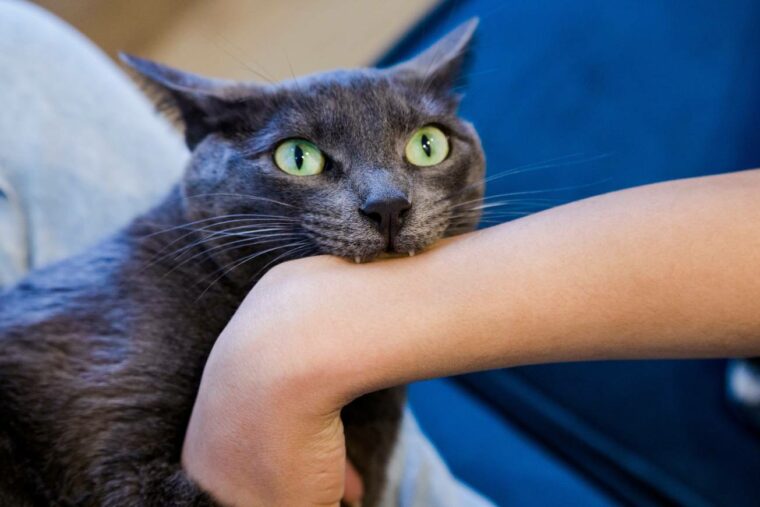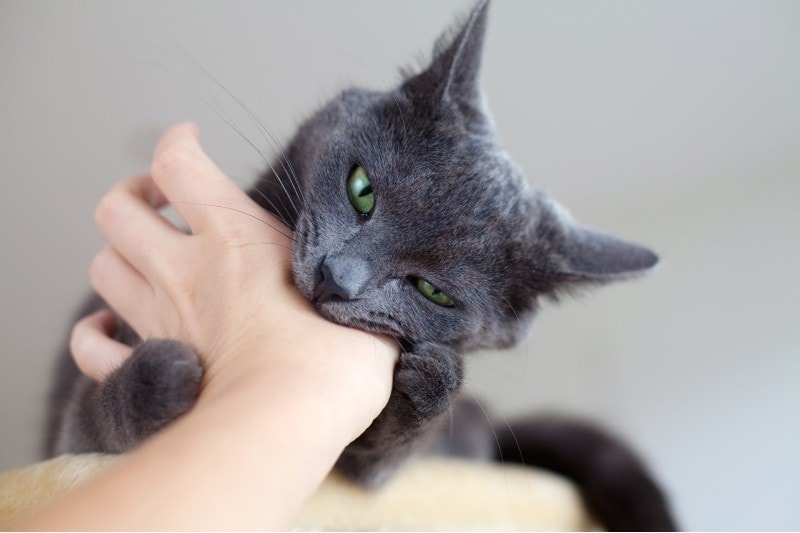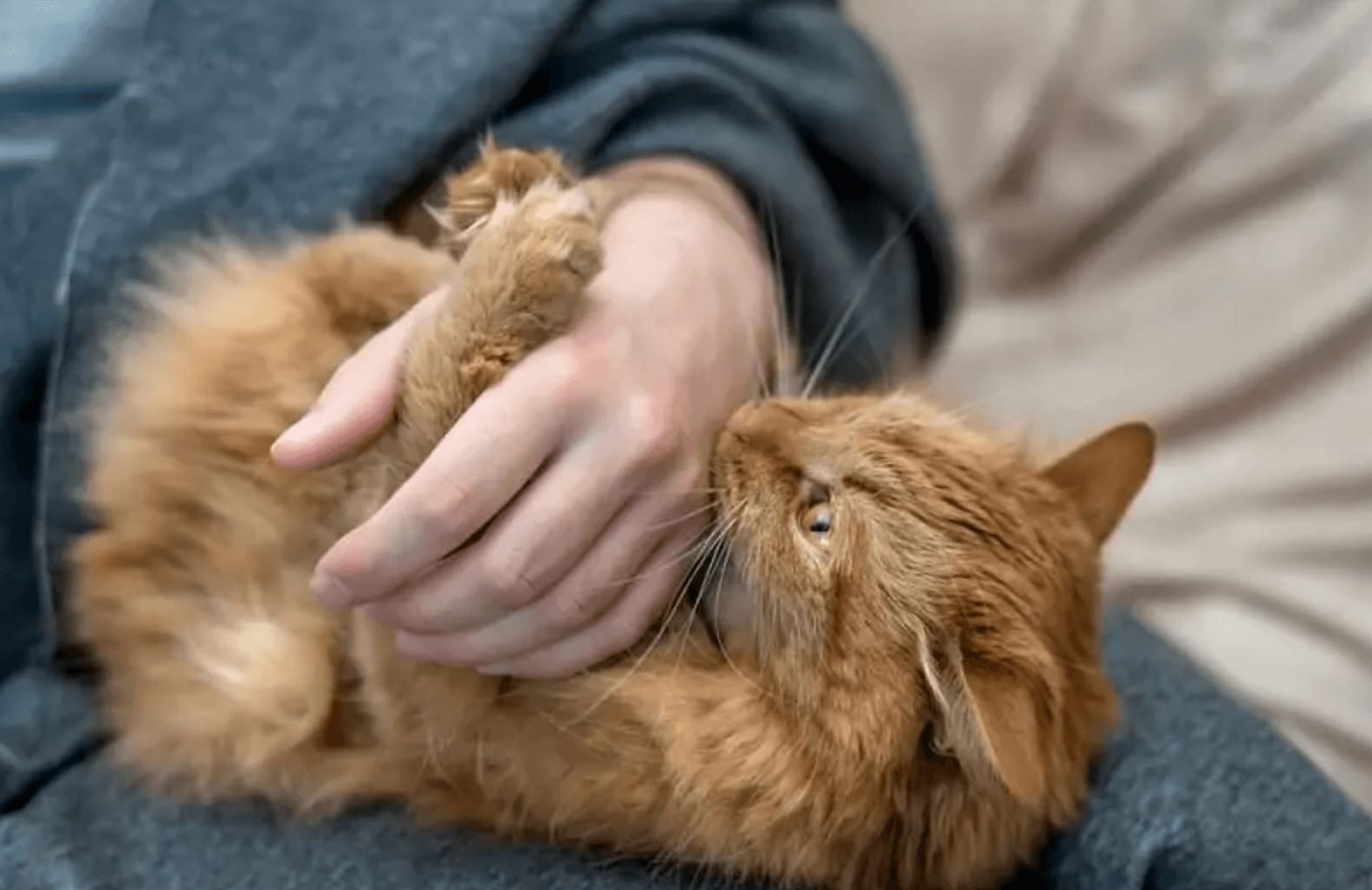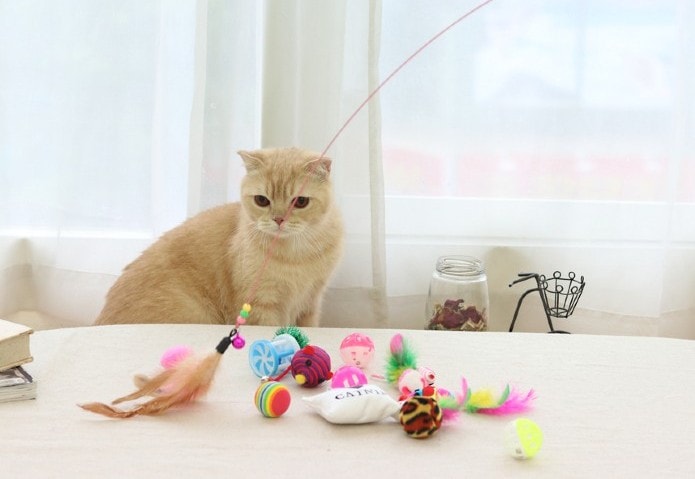
Ever been bitten by your cat? While our feline friends bring us endless joy and companionship, their playful nature can sometimes result in a not-so-playful nip. Whether you’ve been on the receiving end of a love bite or are simply looking to prevent future incidents, you’ve come to the right place. Cats may bite for a number of different reasons, and here we’ll explain what to do if a cat bites you as well as discuss why cats bite and ways to redirect this behavior.
The 3 Steps to Take Immediately After a Cat Bite
Cat bites can be painful and potentially dangerous, as cats have sharp teeth that can easily penetrate the skin. If you’ve been bitten by a cat, it’s essential to take immediate action to prevent infection and promote healing. Here are the steps you should take immediately after a cat bite.
1. Wash the Wound
First, you should wash the wound thoroughly with soap and warm water. This step is crucial to remove any bacteria or dirt that may be present on the surface of the skin. Gently clean the area around the bite, making sure to get into any crevices or folds in the skin. Avoid using harsh chemicals or antiseptics (like rubbing alcohol), as these can further irritate the wound. After washing, pat the area dry with a clean towel or tissue.

2. Grab the Antibiotic
The next step is to apply an over-the-counter antibiotic ointment to the wound. This will help prevent infection and promote healing. Be sure to follow the instructions on the packaging for proper application. It’s important to note that if the wound appears to be deep or is bleeding excessively, you should seek medical attention immediately–in rare cases, stitches may be necessary.
3. Cover the Wound
After applying the antibiotic ointment, cover the wound with a sterile bandage or dressing. This will provide a barrier against bacteria and dirt, reducing the risk of infection. Change the bandage and reapply the antibiotic regularly, at least once a day or whenever it becomes wet or dirty. Keep an eye on the wound for any signs of infection, such as increasing redness, swelling, or pus. And if you notice any concerning signs or if there’s no improvement in the wound after a few days, it’s advisable to seek medical attention asap.

Recognizing Signs of Infection
After a cat bite, it’s crucial to monitor the wound for signs of infection. Promptly identifying and treating an infection can help prevent complications. Here are some common signs of infection to watch out for.
Redness/Swelling
Swelling around the cat bite that persists or worsens over time may indicate an infection. Pay attention to any significant changes in the size or shape of the affected area. If you notice the swelling getting bigger or changing color, it may be best to seek medical attention.

Redness
If the area around the cat bite becomes increasingly red or starts to spread, it may be a sign of infection. Redness that extends beyond the immediate area of the bite should be taken seriously–especially if the area is growing more sensitive to the touch hours after the bite.
Increased Pain
While some pain and discomfort are expected after a cat bite, an increase in pain that is disproportionate to the severity of the wound may be a sign of infection. In some cases, this can also be accompanied by pus or increased irritation–such as burning or aching pain.
Pus or Discharge

If the cat bite wound starts to produce pus or any other type of discharge, it’s likely infected. Pus is a thick, yellowish fluid that indicates the presence of bacteria. It’s best that you not try to break your skin to remove the pus–doing so can just make it worse–but instead seek medical attention
Fever
Fever is a common sign of an infection–especially after an animal bite. So, if you develop a fever after a cat bite, especially if accompanied by other signs of infection, seek medical attention promptly. Other common signs of serious infection include nauseousness, sweating, and lethargy.
When to Seek Immediate Medical Attention for a Cat Bite

While many cat bites can be managed with proper first aid and wound care, it’s important to know when to seek medical attention. Prompt medical intervention is necessary in certain situations to prevent complications and ensure appropriate treatment. Here are some instances where immediate medical attention should be sought.
Deep or Severe Wounds
If the cat bite is deep, has caused significant tissue damage, or is bleeding heavily, seek medical attention immediately. Deep wounds have a higher risk of infection and may require stitches or other medical interventions. For example, if the wound is gaping open, chances are that you’ll need stitches, so you’ll need to seek medical care immediately.
Signs of Infection
As mentioned earlier, if the cat bite wound shows signs of infection, such as increasing redness, swelling, or the presence of pus, it’s important to consult with a healthcare professional. They can assess the wound, give you some antibiotics, and provide appropriate treatment.

Delayed Wound Healing
It’s important to monitor the progress of a cat bite wound after providing proper wound care. If the wound does not show signs of improvement or starts to worsen, you may want to seek medical care. Delayed wound healing can be an indication of an underlying infection or complications. Infections can occur when bacteria from the cat’s mouth enter the wound, leading to inflammation and delayed healing. Additionally, complications such as abscesses or cellulitis may develop if the wound is not properly treated.
Systemic Symptoms
If you experience systemic symptoms such as fever, fatigue, or swollen lymph nodes following a cat bite, it’s best to see a doctor. Why? Because these symptoms may be indicative of an infection that requires medical intervention. Cat bites can actually introduce bacteria into the body, leading to potentially serious complications. Infections from cat bites can spread rapidly and may result in abscess formation or systemic infections. Timely medical evaluation and treatment are essential to prevent further complications and ensure a swift recovery.
Uncertain Vaccination Status
If you’re unsure about the vaccination status of the cat that bit you, it’s advisable to consult with a healthcare professional. They can assess the risk of potential infections and provide appropriate preventive measures, such as a tetanus booster or rabies vaccination. Remember, it’s always better to err on the side of caution when it comes to cat bites–even if the bite is from your own cat.
Potential Complications of Cat Bites
While cat bites may seem harmless at first, they can lead to various complications if not properly treated. So be aware of the potential risks to ensure prompt medical intervention when necessary. Here are some potential complications of cat bites:
Tetanus
Tetanus is a potentially life-threatening infection caused by the bacteria Clostridium tetani. This infection can enter the body through deep wounds, especially those caused by animal bites, such as cat bites. Tetanus can cause severe muscle stiffness and spasms, which can lead to difficulty breathing and swallowing.
So, it’s crucial to take immediate action if you have sustained a deep wound and haven’t received a tetanus vaccine in the past 10 years or are unsure of your immunization status. Seeking medical attention is essential to determine whether a booster shot is necessary to protect against tetanus and prevent potential complications.
Rabies
Rabies is a viral disease that affects the central nervous system of mammals–including humans. The diseases can easily be transmitted by the bite or scratch of an infected animal. While dogs are commonly associated with rabies, it’s important to note that stray cats can also carry and transmit this disease. Stray cats, especially those without regular vaccinations and proper healthcare, are at a higher risk of being infected with rabies. Therefore, it’s crucial to exercise caution when encountering stray cats, as they can potentially transmit this deadly virus–and it spreads within hours so immediate treatment is crucial.

Infection
As mentioned earlier, cat bites have a high risk of infection due to the bacteria present in a cat’s mouth. If the wound isn’t cleaned and treated appropriately, the bacteria can multiply, quickly leading to an infection. Signs of infection include redness, increased pain, swelling, and pus discharge. So, to prevent infection, be sure to cover the wound, avoid submerging it in unclean water (and it’s best to keep it dry), and keep it clean.
Cellulitis
Cellulitis is a common skin infection that can occur as a result of a cat bite. When a cat bites, bacteria from its mouth can enter the skin, causing an infection. The affected area usually becomes red, swollen, and tender. If you suspect that you have cellulitis, prompt treatment is a must to avoid complications. If left untreated, cellulitis can spread to deeper tissues and potentially lead to more severe issues such as abscess formation or the spread of infection to the bloodstream.
Cat Scratch Disease
Cat scratch disease is a bacterial infection caused by a bacterium called Bartonella henselae. The disease is commonly transmitted through cat scratches and bites. Symptoms may include a small bump or blister at the site of the bite, swollen lymph nodes, fever, and fatigue. Medical treatment may be necessary to manage the infection.
Main Reasons Why Cats Bite Humans
Cats are known for their super independent and sometimes hilariously unpredictable nature. There are several reasons why a cat may resort to biting. Here are the most common ones.
Playful Behavior

Cats often use biting as a form of play, just like dogs. So, they may nip at your hands or feet during interactive play sessions. While it may seem harmless, it’s important to set boundaries to prevent bites from becoming more aggressive, particularly in older cats.
Fear or Anxiety
Cats may bite when they feel threatened or scared. This can happen in situations such as being cornered, encountering unfamiliar people or animals, or experiencing a sudden loud noise. Understanding your cat’s triggers can help you avoid situations that may lead to bites and other aggressive behavior (they may also scratch and paw at your face).
Pain or Discomfort
Note that felines may bite if they’re experiencing pain or discomfort. This can be a sign of an underlying health issue, such as dental problems or arthritis. If your cat’s behavior suddenly changes and they become more prone to biting, it’s important to consult with a vet to rule out any medical conditions. It’s important to note that not all cat bites are aggressive.
Some cats may give “love bites” as a sign of affection, but they hurt. These bites are usually gentle and not intended to harm. However, it’s still crucial to discourage this behavior to prevent it from escalating into more aggressive biting.
Preventing Cat Bites in the Future

Prevention is key when it comes to cat bites. By understanding your cat’s behavior and taking appropriate measures, you can minimize the risk of bites and create a safer environment for both you and your feline buddy. Here are some tips to prevent cat bites in the future.
Learn to Understand Your Cat’s Body Language
Cats are known for their ability to communicate through body language. By paying attention to their ears, tail, and overall posture, we can gain insights into their mood and potential triggers. When a cat’s ears are pointed forward and relaxed, it indicates that they are calm and content. Conversely, if their ears are flattened against their head, it may signal fear or aggression.
The position of their tail also plays a role in their communication. A relaxed and upright tail suggests a friendly and approachable mood, while a puffed-up tail indicates anxiety or agitation. Additionally, observing a cat’s overall posture, such as the position of their body and the tension in their muscles, can provide further clues about their emotional state. By being attentive to these subtle cues, we can better understand our feline companions and anticipate situations that may lead to biting.
Provide Appropriate Outlets for Play and Exercise
Cats, like any other living beings, require mental and physical stimulation to lead a healthy and fulfilling life. Providing them with toys, scratching posts, and regular playtime sessions is essential in keeping them entertained and preventing boredom or frustration–something that can lead to aggression and biting. Toys such as interactive puzzles or feather wands can engage their minds and keep them mentally stimulated.
Regular playtime, whether it’s simply chasing a toy or engaging in interactive play with their owner, helps cats burn off excess energy and prevents them from becoming bored or frustrated. These measures are crucial in preventing unwanted behaviors such as biting, which can often be a result of pent-up energy or frustration.

Avoid Rough Play
Engaging in rough play with your cat may seem tempting, especially when they’re full of energy and excitement. However, it’s crucial to set boundaries and avoid activities that may encourage biting. Rough play can potentially lead to aggressive behavior in cats and can cause harm to both the cat and the owner. Instead, try to focus on interactive play sessions using toys that keep a safe distance between your hands and your cat’s mouth.
This not only ensures the safety of both parties involved but also provides a healthy outlet for your cat’s natural instincts. By redirecting their energy towards appropriate toys, you can strengthen the bond with your feline friend while promoting positive behavior.
Wrapping Things Up
There are several reasons why a cat may bite, including fear, aggression, or even playfulness. It’s important to take steps to clean and cover a cat bite ASAP to prevent infection and other issues. It’s also important to understand the underlying cause of the biting in order to effectively prevent it. Lastly, it’s crucial to never punish or physically harm your cat for biting, as this can exacerbate the issue and lead to more aggressive behavior. Instead, focus on positive reinforcement and reward-based training methods to encourage good behavior and discourage biting.
Featured Image Credit: Madame-Moustache, Shutterstock







